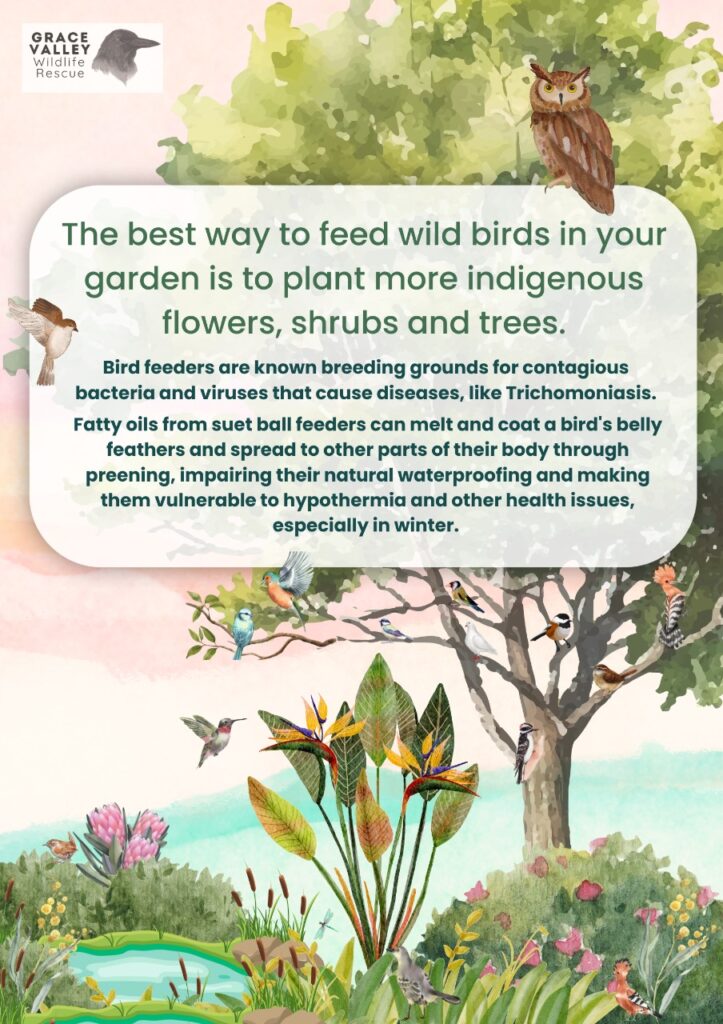
If you decide to feed wild birds in your garden, always make sure feeding stations and bird baths are disinfected regularly. And most importantly PLEASE DO NOT USE PESTICIDES in your garden! Most birds actually eat bugs and pesticides not only mean less food for wild birds, but when a bird eats a poisoned insect they suffer a slow and terrible death!
Here are some more tips to make sure you are not causing any harm to your feathered friends ~
Do:
- Plant a bird friendly garden: The absolute best food for any wild animal is the food they should be able to find in their natural habitats. Overdevelopment decreases natural foraging opportunities for our native species and planting a bird friendly garden that offers shelter and protection as well as food is a wonderful way to work with your natural ecosystems and create a sustainable wildlife-friendly garden that you and your wild garden visitors can enjoy.
Choose trees, shrubs and groundcovers that offer leaves, seeds and nectars to birds as well as those that are good at attracting the insects, larvae and grubs that birds rely on. Animals are incredibly intuitive about which types of foods to eat and when to eat them so as to meet their specific mineral and energy needs throughout the seasons, so plating a variety of options is key.
Start with researching which birds naturally visit your garden or occur in your area and which native plants support their natural and varied diets throughout the year.
Here are some examples to consider ~
Halleria lucida (Tree Fucia) is regarded as one of the most valuable plants to have in a bird garden as it attracts sunbirds, white-eyes, thrushes, robins, pigeons, flycatcher, louries, mousebirds and barbets.
Plectranthus verticillatus (gossip plant) is a fast growing ground cover with dark green and maroon foliage and white purple marked flowers, it does very well in the shade. Most Plectranthus species are host plants to an amazing number of butterfly larvae which are relished by many birds.
The Indigenous Gardener has a great article on their website about their top 10 indigenous plants and which birds they attract, which you can read here - Create a Safe Environment for supplementary feeding stations and bird baths: If you choose to offer supplementary feed to your local wild birds, place feeders and bird baths away from areas where predators, such as cats, may lurk. Providing cover nearby, like bushes or trees, can offer birds protection from predators while they feed.
- Clean Feeders and Water Stations Regularly: Regular cleaning of feeders and water stations is crucial for preventing the spread of diseases among bird populations. One particular threat is Trichomonas gallinae, a parasitic protozoan that commonly infects the upper digestive tracts of many birds, particularly pigeons and doves and also chickens and even raptors. It can be transmitted through contaminated food and water sources, making unclean bird feeders a potential breeding ground for the parasite. Use non-toxic agents such as vinegar to regularly disinfect feeders to remove any build-up of mould, bacteria, or parasites.
- Provide Fresh Water: Birds need access to clean water for drinking and bathing. Keep bird baths clean and filled with fresh water.
Don’t:
- Do Not Use Highly Processed Commercial Treats: Avoid offering birds highly processed commercial treats, as they may lack essential nutrients and could be harmful to bird health in the long run.
- Avoid Suet: According to NativeBirdCare.org, there are a lot of home-made suet recipes that are simply dangerous for birds, even deadly. The fact is fats can get on birds’ feathers and harm their ability to stay dry and warm. This lack of weatherproofing and impairment in insulation is deadly in the winter, but also the summer. The most dangerous fats for birds are the soft fats, those that are easily spread. Birds get fats on them by landing directly on a suet ball or feeder and getting the fats onto their feet. The fat is then spread as birds use their feet to preen their heads and for scratching themselves. Fats also spread by a bird having residue on their bill and then preening. Greasy birds are dead birds. Oils on feathers impair weatherproofing by interrupting the feathers’ structural function. A birds’ feathers are like a wet-suit; create a ‘hole’ in that suit and you get water or cold air access causing the bird to become cold (called ‘hypothermia’). Hypothermia kills birds, and often in far less time than one can imagine.
- Avoid Peanuts: Peanuts, like other nuts, can be susceptible to often invisible mould growth, especially when stored in damp or humid conditions. Mould growth on peanuts can produce toxins known as mycotoxins, which can be harmful to birds if ingested. Aflatoxins are a group of mycotoxins produced by certain moulds, particularly Aspergillus species, that commonly contaminate peanuts. These toxins are known to be carcinogenic and can cause liver damage and immune suppression in birds.
Respiratory Issues: Inhaling mould spores from contaminated peanuts can also pose respiratory risks to birds, leading to respiratory distress or infections.
Digestive Problems: Ingesting mouldy peanuts can lead to digestive issues in birds, including diarrhoea, vomiting, and dehydration, which can weaken their overall health and immune system. - Avoid red dyes in hummingbird feeders: The plants the hummingbirds feed on need the hummingbirds to pollinate them! Rather give them a clean, fresh source of water and get to planting some hummingbird loving plants!
By following these simple guidelines, you can create a safe and inviting environment for wild birds to thrive in your backyard while minimizing the risk of disease transmission and promoting their overall well-being.





![Give A HOOT! [Watch]](https://gracevalleyhaven.co.za/wp-content/uploads/2025/05/Spotty.jpg)

![Going Batty [Watch]](https://gracevalleyhaven.co.za/wp-content/uploads/2024/04/trevor-gerzen-jC8uzTM8PlM-unsplash-1.jpg)
Leave a Reply